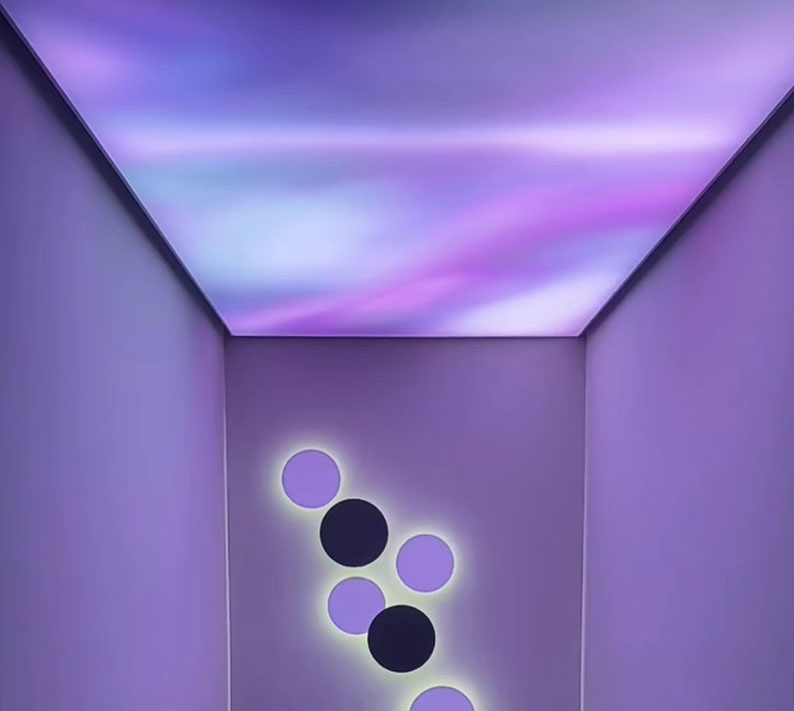The stretch ceiling light market, encompassing soft membrane lighting systems, is experiencing dynamic growth, fueled by technological advancements and evolving design preferences. These systems, where LEDs are integrated behind a tensioned translucent membrane, are moving beyond mere functionality to become central architectural elements. Here are the defining trends driving this vibrant sector:
1. The Rise of Bespoke Brilliance:
Shape Shifters:The era of standard squares and rectangles is fading. Demand surges for custom geometric shapes (circles, ovals, organic curves, intricate polygons) and seamless large-scale installations that become dramatic focal points.
Sculptural Lighting:Manufacturers are pushing boundaries with 3D form and multi-level designs, creating truly sculptural illuminated ceilings that add depth and dimension to spaces.
Tailored Perfection: Clients increasingly expect solutions tailored to exact dimensions, unique layouts, and specific aesthetic visions, driving the need for advanced design and manufacturing capabilities.
2. Smart Integration & Human-Centric Lighting (HCL):
Beyond On/Off: Stretch ceilings are becoming sophisticated platforms for smart lighting systems. Integration with building automation (BAS) and IoT platforms allows for remote control, scheduling, and scene setting via apps or voice assistants.
Tuning to Well-being:HCL principlesare a major driver. Systems now offer tunable white light (adjusting CCT from warm to cool) and even full RGBW color capabilities, mimicking natural daylight cycles to enhance occupant mood, focus, and circadian rhythms in offices, healthcare, and homes.
3. Material Innovation & Enhanced Performance:
Superior Diffusion: New fabric blends and micro-perforated membranes offer exceptional light diffusion, eliminating hotspots and glare for truly uniform, comfortable illumination – a key requirement in premium applications.
Functionality Focus: Development continues on acoustically absorptive fabrics, anti-bacterialand easy-clean coatings (especially vital for healthcare and hygiene-sensitive areas), and improved fire-retardantproperties meeting stringent safety codes.
Textural Interest: While smooth finishes dominate, there’s growing interest in subtly textured membranes that add visual depth when illuminated.
4. Sustainability as Standard:
LED Synergy: The inherent efficiency of LED technology is perfectly matched with stretch ceilings. The focus intensifies on using ultra-high-efficiency LEDs, advanced drivers, and sustainable materials in both the membrane and supporting components.
Longevity & Lifecycle:Manufacturers emphasize extended product lifespans (LEDs and fabrics) and recyclability of materials, aligning with green building certifications (LEED, BREEAM, WELL) and corporate ESG goals.
5. Architectural Integration & Seamlessness:
Hidden Marvels: The core appeal remains the “invisible” hardware. Continuous innovation focuses on even sleeker edge profiles, concealed access points, and integration techniques that make the light source appear magically embedded within the ceiling plane.
Cohesive Environments: Stretch ceilings are increasingly used to integrate other building services seamlessly – HVAC vents, sprinklers, speakers – maintaining a clean, uncluttered aesthetic while housing complex functionality.
6. Expanding Application Horizons:
Beyond Commercial: While strong in retail, offices, and hospitality, adoption is rapidly growing in high-end residential projects seeking statement lighting and specialized sectors like healthcare (calming environments), education (focused lighting), museums (artifact-friendly illumination), and luxury transportation hubs.
Brand Storytelling: Custom shapes, colors, and even printed graphics or backlit logos directly onto the membrane are powerful tools for brand identity in retail and corporate settings.
Why It Matters:
The stretch ceiling light industry is no longer just about providing light; it’s about creating immersive, intelligent, and sustainable luminous environments. The convergence of customizable design, smart technology, human-centric benefits, and eco-conscious manufacturing positions these systems at the forefront of architectural lighting. As technology evolves and designers demand ever more sophisticated tools, we can expect stretch ceilings to continue pushing the boundaries of how light defines and enhances the spaces we inhabit, moving firmly from a niche solution to a mainstream architectural lighting staple. The future is bright, seamless, and intelligent.

